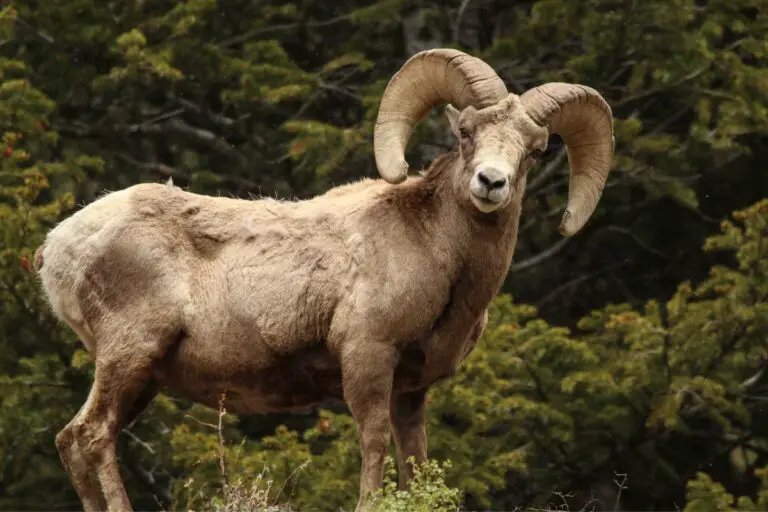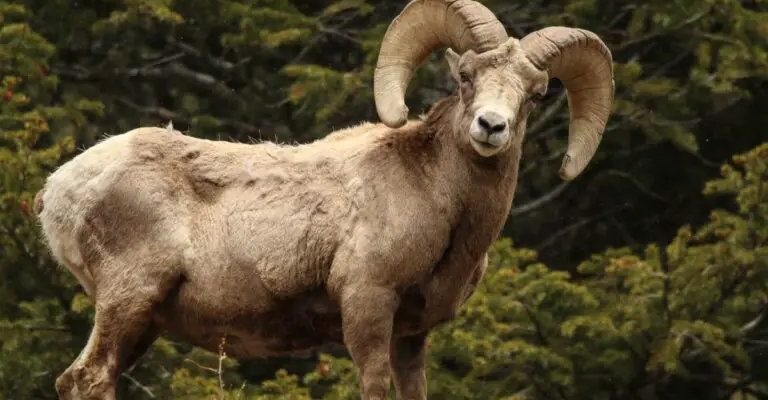
In this article, we’re diving into ten animals that resemble the bighorn sheep and exploring what makes each of them unique. Whether you’re a wildlife enthusiast or just curious about nature, understanding these animals can add a whole new layer of appreciation for our world’s biodiversity. So grab your binoculars, and let’s embark on this journey together!
1. Mountain Goat
Mountain goats are often mistaken for bighorn sheep due to their shared habitat in the mountains, but they have some key differences. For starters, mountain goats have longer, more slender bodies, and their fur is pure white, which helps them blend into snowy environments. The bighorn sheep, in contrast, sport a tan or grayish coat that’s perfect for blending into rocky terrain.
Another notable feature is their horns. While bighorn sheep have thick, curled horns, *mountain goats* have straight, pointed horns that can grow up to 12 inches long. They are also more agile on steep, rocky surfaces, thanks to their specialized hoof structure. When you spot one of these goats clambering across a cliff, it’s like watching a ballet dancer balancing on the edge of a stage!
Differences to Remember
- Color: Mountain goats are white; bighorn sheep are tan or grayish.
- Horns: Mountain goats have straight, pointed horns; bighorn sheep have curled horns.
- Body Shape: Mountain goats are more slender; bighorn sheep are stockier.
2. Nubian Goat
Next up is the Nubian goat, a domesticated breed that’s often recognized for its long, floppy ears and friendly nature. While they might look cute and cuddly, Nubian goats share some physical traits with bighorn sheep, particularly their stocky build and curved horns. However, these goats come in a variety of colors, from black to white to multicolored patterns.
What really sets Nubian goats apart is their social behavior. They’re known for being very vocal and affectionate, often forming strong bonds with their human caretakers. Unlike bighorn sheep, which tend to be more solitary or live in small groups, Nubian goats thrive on companionship.
Key Features
- Domestication: Nubian goats are domesticated, while bighorn sheep are wild.
- Color Variability: Nubians come in many colors; bighorn sheep have a more uniform appearance.
- Behavior: Nubians are social and vocal; bighorn sheep are more reserved.
3. Dall Sheep
If you’re exploring the North American mountains, you might encounter the Dall sheep. These stunning creatures are often confused with bighorn sheep due to their similar habitats and body shapes. However, Dall sheep have a few distinguishing features. They are mostly white, which helps them blend into their snowy surroundings, unlike the bighorn’s darker fur.
When it comes to horns, male Dall sheep have beautifully curled horns, but they tend to be smoother and less robust than those of bighorn sheep. Dall sheep are also more likely to be found in the northern ranges, whereas bighorn sheep prefer southern regions. Imagine walking through a snowy landscape and spotting this elegant animal—it’s a sight you won’t forget!
Distinguishing Traits
- Color: Dall sheep are predominantly white; bighorn sheep are brownish.
- Horn Shape: Dall sheep have smoother, more delicate curls; bighorn sheep have thicker, more pronounced curls.
- Habitat Range: Dall sheep are found in northern regions; bighorn sheep inhabit southern areas.
4. Argali Sheep
The Argali sheep is another close relative of the bighorn sheep. Found in Central Asia, they are known for being the largest wild sheep species. These magnificent animals are recognized by their massive horns, which can spiral impressively around their heads. While bighorn sheep have strong, curled horns, Argali horns tend to be more elongated and dramatically curved.
In addition to their size and horn structure, Argali have a thicker wool coat, which is essential for survival in their cold mountainous habitats. They often travel in larger herds compared to bighorn sheep, which tend to be more solitary or in smaller groups. It’s fascinating to see how these great creatures navigate their rugged homes, reminding us of the diversity in the animal kingdom.
Notable Differences
- Size: Argali sheep are larger than bighorn sheep.
- Horn Structure: Argali horns are longer and more elongated; bighorn horns are thicker and more curled.
- Coat: Argali have a thicker wool coat compared to bighorn sheep.
5. Bushbuck
Now, let’s look at something a bit different—the bushbuck. While not a sheep, bushbucks can be confused with bighorn sheep due to their similar size and habitat preferences. These antelopes have a robust built and often inhabit bushy areas near water sources in Africa. Though they lack the iconic horns of sheep, male bushbucks can have twisted, sharp antlers that give them a rugged appearance.
Bushbucks are typically brown with white markings, making them blend into their surroundings perfectly. Unlike bighorn sheep, which are well-adapted for rocky terrains, bushbucks are more agile in dense vegetation. Picture a bushbuck darting through the underbrush—it’s agility in motion!
Contrasting Features
- Species: Bushbuck is an antelope, while bighorn sheep are ovine.
- Horns vs. Antlers: Bushbucks have antlers; bighorn sheep have true horns.
- Habitat: Bushbucks prefer dense foliage; bighorn sheep thrive in rocky areas.
6. Spanish Goat
The Spanish goat is another domesticated breed that shares a resemblance with bighorn sheep. These goats are known for their hardy nature and ability to adapt to various environments. Spanish goats can have short, curved horns similar to those of bighorn sheep, but their overall build is generally leaner and more agile.
What’s interesting about Spanish goats is their diversity. They can come in many colors and are often raised for meat and fiber. Unlike the more solitary bighorn sheep, Spanish goats usually prefer to be in larger groups. If you’ve ever seen one of these goats bounding around a farm, you’ll know just how lively they can be!
Key Differences
- Purpose: Spanish goats are domesticated for meat and fiber; bighorn sheep are wild.
- Body Type: Spanish goats are leaner; bighorn sheep have a stockier build.
- Social Behavior: Spanish goats are more social; bighorn sheep can be more solitary.
7. Tahr
Moving on, let’s talk about the tahr. Native to the Himalayas and surrounding areas, tahrs are large, muscular animals with shaggy coats that help them withstand cold climates. They have curved horns similar to bighorn sheep, but unlike their more robust relatives, tahrs have a more elongated body and thicker fur.
One of the fascinating aspects of tahrs is how they navigate steep terrains. Their unique hoof structure allows them to climb rocky cliffs effortlessly, much like bighorn sheep. You might see them jumping from one ledge to another, and it’s a reminder of how adapted these animals are to their environments.
Unique Characteristics
- Coat: Tahr has a shaggy coat; bighorn sheep have a shorter, softer coat.
- Body Shape: Tahrs are more elongated; bighorn sheep are stockier.
- Habitat: Tahrs are found in the Himalayas; bighorn sheep are in North America.
8. Chamois
The chamois is another mountain-dwelling animal that shares some traits with bighorn sheep. Found in the European Alps, chamois have a compact body and short, curved horns, resembling those of bighorn sheep. However, chamois are generally smaller and have a more goat-like appearance with a unique face pattern.
What makes chamois stand out is their incredible agility. They can navigate steep and rocky slopes with grace, often leaping between narrow ledges. This quality, combined with their light tan fur, gives them a striking look as they blend seamlessly into their environment. Watching a chamois move through the mountains is like witnessing a live-action nature documentary!
Differences to Spot
- Size: Chamois are smaller than bighorn sheep.
- Facial Patterns: Chamois have distinctive facial markings; bighorn sheep do not.
- Habitat Range: Chamois live in European mountains; bighorn sheep are in North America.
9. Wild Goat
Lastly, the wild goat (also known as the bezoar goat) is a fascinating animal that’s closely related to domestic goats and shares some traits with bighorn sheep. These goats have a robust body and long, curved horns, giving them a striking resemblance. However, wild goats are more muscular and well-adapted to rocky terrains.
One interesting fact about wild goats is their ability to thrive in harsh environments. They can often be seen grazing on steep hillsides, proving their agility and strength. While bighorn sheep and wild goats may look similar at a glance, their habitats can be quite different, with wild goats often found in more rugged terrain compared to the bighorn’s preferred spaces.
Key Distinctions
- Build: Wild goats are more muscular; bighorn sheep are bulkier.
- Horns: Wild goats have longer, more prominent horns; bighorn sheep have shorter, thicker horns.
- Habitat: Wild goats prefer rugged terrains; bighorn sheep are found in less extreme environments.
10. Soay Sheep
Finally, let’s explore the Soay sheep, a breed that’s often found on the islands of Scotland. These small, primitive sheep resemble bighorn sheep in size and some physical characteristics, but they have significantly shorter horns and a more slender frame. Their wool is also quite different, being finer and softer compared to the bighorn’s coarser fleece.
While Soay sheep are domesticated, they often live in free-roaming flocks, making them similar to their wild counterparts. Watching them graze in their natural habitat can be a peaceful sight, reminiscent of how bighorn sheep behave in the wild. It’s like seeing a slice of history, as these sheep represent a lineage that dates back thousands of years.
Last Differences to Note
- Size: Soay sheep are smaller than bighorn sheep.
- Horns: Soay sheep have shorter horns; bighorn sheep have prominent curled horns.
- Wool Quality: Soay sheep have finer wool; bighorn sheep have thicker fleece.
In conclusion, while the bighorn sheep is a stunning example of wildlife, there are many other animals that share similarities with it. Each of these creatures brings its own unique qualities and adaptations to the table, making our world rich with diversity. Next time you spot a bighorn sheep or one of its relatives, you’ll be able to appreciate not just their beauty, but also the fascinating traits that set them apart. Nature never ceases to amaze, right?

